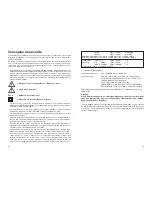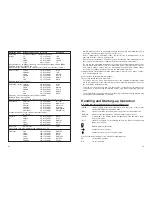
30
Note!
The integrated 10A fuse can be checked in an easy way: Set the measuring
instrument to the acoustic continuity check (see „Measuring resistance values“
for connecting the measuring lines) and connect the measuring prod to the 20A
input. If an audio signal is generated, the fuse is OK. If „0L.“ is indicated, the
fuse is defect and has to be replaced. When doing this, observe the safety
instructions.
If you want to check a fuse of the µA/ mA-input, it will be necessary to open the
instrument.
Measuring temperatures (only for the VC-840)
For measuring the temperature you need the temperature sensor supplied. So called
NiCrNi (i.e.: nickel-chromium-nickel type K) sensors are used to measure the temper-
ature. The temperature measurement range starts at -40°C and terminates at
+1000°C. It is possible to measure temperatures up to +400°C by using the wire-sen-
sor included in the scope of delivery of the VC-840. When doing this it is important
that only the sensor prod and not the measuring instrument is exposed to these tem-
peratures.
Proceed as follows to measure temperatures:
a) Connect the 4mm banana plug of the temperature sensor with the measuring
instrument, „–“ with „COM“ and „+“ with the „/mA/°C“ socket. Ensure the right
polarity
b) Move the rotary switch to “°C” and turn on the measuring instrument. After a brief
initialisation phase, the measuring instrument is ready for operation.
c) Connect the sensor prod of the thermoelement with the voltage-free object to be
measured. Hold the temperature sensor at or into the measuring object as long as
the display has stopped moving (about 30 seconds or shorter).
Caution!
Do not connect any current. This could damage the instrument.
Notes!
The following subfunctions can be set:
Holding the measuring value „HOLD H“ and reference measurement „REL“.
It is also possible to connect commercially available K-type temperature sensors
provided with a standardised flat plug to the VC-840 via an optionally available tem-
perature/component adapter.
Connecting a computer
The optoelectronic unidirectional (into one direction) interface to a PC in form of an
IR diode is positioned at the top of the rear side of the measuring instrument. The
serial interface is always active, indicated by the „RS232C“ symbol in the header of
the display.
The following steps are to be performed to allow the communication between an
(IBM-compatible) PC and your measuring instrument:
27
Normally, the resistance of the measuring lines is so low (ca. 0.1 to 0.2 ohms)
that it can be neglected. However, this low resistance can even result in inac-
curate values within the 400 ohm measuring range.
Therefore, use the REL function to avoid the indication of the resistance of the
measuring lines.
For a resistance >1mΩ the electronic system needs a little bit of time to
stabilise the indication.
Testing diodes and checking the acoustic continuity
Proceed as follows to test diodes and semiconductor paths or to check the acoustic
continuity of voltage-free lines / fuses:
a) The measurement set-up (connection of the measuring lines) corresponds to the
one of the resistance measurement. Press the blue second-function button once.
Now, the measuring instrument switches from resistance measurement to diode
test, the „
“ symbol becomes visible on the right side of the display.
b) „.0L“ for overload is indicated for open or not connected measuring lines or for
high-resistance (or interrupted) semiconductor paths. Connect the measuring
prods to the voltage-free semiconductor component, a diode or a transistor.
When doing this make sure that the red measuring line is connected to the anode
and the black measuring line to the cathode. Now, the forward direction is tested.
If the p-n-junction functions properly, a value of between 0.45 and 0.75VDC will
be displayed for Si-diode paths and a value of between 0.2 and 0.4VDC will be
shown for Ge-diode paths. But if „.0L“ appears instead of a voltage value, the
diode path is interrupted or the measuring lines have been mixed up. If a voltage
higher than 1V is measured for transistors it is possibly a transistor with integrat-
ed resistors.
For light emitting diodes a conducting-state voltage of between approximately 1.2
and 1.5VDC is measured. If it is a low-current LED, the measurement current may
be sufficiently high to cause this LED to emit light.
The reverse direction of a diode path is tested by connecting the cathode with the
red measuring line and the anode with the black measuring line. If a voltage value
is displayed now, the diode is defect. But if „.0L“ is indicated, it is a high-resis-
tance diode path (OK).
c) To switch to the acoustic continuity check, activate the blue second-function
switch top right of the rotary switch once more. Above the „ohm symbol“ the sym-
bol for the acoustic continuity check is displayed. Connect the measuring prod to
the absolutely voltage-free object to be measured (lines, cables, circuits etc.). An
audio signal is generated for resistance values below approximately 70 ohm. The
loudest signal is generated for „0“ ohm.
rote
Meßleitung
schwarze
Meßleitung
Durchlaßrichtung
rote
Meßleitung
schwarze
Meßleitung
Sperrichtung
red measu-
ring line
black mea-
suring line
red measu-
ring line
black mea-
suring line
load, switch
reverse direction


































